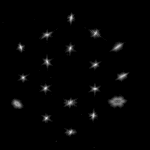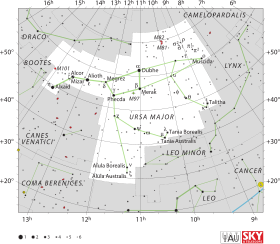HD 84406
It has been suggested that 2MASS J17554042+6551277 be merged into this article. (Discuss) Proposed since March 2022. |
| Observation data Epoch J2000.0 Equinox J2000.0 | |
|---|---|
| Constellation | Ursa Major |
| Right ascension | 09h 47m 30.55s[1] |
| Declination | +63° 14′ 52.09″[1] |
| Apparent magnitude (V) | 6.944[2] |
| Characteristics | |
| Spectral type | G8IV[3] |
| Apparent magnitude (R) | 6.4[4] |
| Apparent magnitude (J) | 5.265 ±0.0002[4] |
| Apparent magnitude (H) | 4.824 ±0.024[4] |
| Apparent magnitude (K) | 4.698 ±0.020[4] |
| Astrometry | |
| Radial velocity (Rv) | 6.97 km/s |
| Proper motion (μ) | RA: −108.464±0.037[1] mas/yr Dec.: −137.615±0.053[1] mas/yr |
| Parallax (π) | 12.6164 ± 0.0310[1] mas |
| Distance | 258.5 ± 0.6 ly (79.3 ± 0.2 pc) |
| Absolute magnitude (MV) | 2.55[3] |
| Details | |
| Mass | 1.4[5] M☉ |
| Radius | 5.1[6] R☉ |
| Luminosity | 13.7[6] L☉ |
| Surface gravity (log g) | 3.355[7] cgs |
| Temperature | 4,905[6] K |
| Metallicity [Fe/H] | −0.055[7] dex |
| Age | 4.5[8] Gyr |
| Other designations | |
| Database references | |
| SIMBAD | data |
HD 84406, is a star approximately 258.5 light-years away in the constellation of Ursa Major. The star is a spectral type G star and has a high proper motion.[4]
On 4 February 2022, HD 84406 was the first star viewed by the James Webb Space Telescope. Relatively isolated, the star was used to test and align the focus of the telescope's 18 primary mirrors.[9][10][11][12] On 11 February 2022, The New York Times reported that "first light" images of HD 84406 from JWST were released—as well as related NASA alignment videos (2/11/2022; 3:00)[13] and (3/16/2022; 3:43).[14]
Gallery[]

18 images of same target star HD 84406 by the 18 unfocused mirror segments.

Phase 1 interim image, annotated with the related mirror segments that took each image.

18 unfocused images of same target star HD 84406.

Phase 1 annotated completion image of HD 84406.

Phase 2 completion, showing "before and after" effects of segment alignment.

Phase 3 completion, showing 18 segments "stacked" as a single image of HD 84406.
References[]
- ^ a b c d e Brown, A. G. A.; et al. (Gaia collaboration) (August 2018). "Gaia Data Release 2: Summary of the contents and survey properties". Astronomy & Astrophysics. 616. A1. arXiv:1804.09365. Bibcode:2018A&A...616A...1G. doi:10.1051/0004-6361/201833051. Gaia DR2 record for this source at VizieR.
- ^ "HYGMap".
- ^ a b Abt, Helmut A. (2004). "Spectral Classification of Stars in A Supplement to the Bright Star Catalogue". The Astrophysical Journal Supplement Series. 155 (1): 175–177. Bibcode:2004ApJS..155..175A. doi:10.1086/423803.VizieR
- ^ a b c d e "HD 84406". SIMBAD. Centre de données astronomiques de Strasbourg. Retrieved 2022-01-25.
- ^ Queiroz, A. B. A.; Anders, F.; Chiappini, C.; Khalatyan, A.; Santiago, B. X.; Steinmetz, M.; Valentini, M.; Miglio, A.; Bossini, D.; Barbuy, B.; Minchev, I.; Minniti, D.; García Hernández, D. A.; Schultheis, M.; Beaton, R. L.; Beers, T. C.; Bizyaev, D.; Brownstein, J. R.; Cunha, K.; Fernández-Trincado, J. G.; Frinchaboy, P. M.; Lane, R. R.; Majewski, S. R.; Nataf, D.; Nitschelm, C.; Pan, K.; Roman-Lopes, A.; Sobeck, J. S.; Stringfellow, G.; Zamora, O. (2020). "From the bulge to the outer disc: Star Horse stellar parameters, distances, and extinctions for stars in APOGEE DR16 and other spectroscopic surveys". Astronomy & Astrophysics. 638: A76. arXiv:1912.09778. Bibcode:2020A&A...638A..76Q. doi:10.1051/0004-6361/201937364. S2CID 209439697.
- ^ a b c McDonald, I.; Zijlstra, A. A.; Watson, R. A. (11 October 2017). "Fundamental parameters and infrared excesses of Tycho–Gaia stars". Monthly Notices of the Royal Astronomical Society. 471 (1): 770–791. arXiv:1706.02208. Bibcode:2017MNRAS.471..770M. doi:10.1093/mnras/stx1433. ISSN 0035-8711.
- ^ a b Stevens, Daniel J.; Stassun, Keivan G.; Gaudi, B. Scott (29 November 2017). "Empirical Bolometric Fluxes and Angular Diameters of 1.6 Million Tycho-2 Stars and Radii of 350,000 Stars with Gaia DR1 Parallaxes". The Astronomical Journal. 154 (6): 259. arXiv:1708.05025. Bibcode:2017AJ....154..259S. doi:10.3847/1538-3881/aa957b. ISSN 0004-6256.
- ^ Feuillet, Diane K.; et al. (2016). "Determining Ages of APOGEE Giants with Known Distances". The Astrophysical Journal. 817 (1): 40. arXiv:1511.04088. Bibcode:2016ApJ...817...40F. doi:10.3847/0004-637X/817/1/40. S2CID 118675933.
- ^ Dvorsky, George (4 February 2022). "Webb Space Telescope Successfully Sees Its First Glimmer of Light - HD 84406 will go down in history as the first star spotted by the $10 billion space telescope". Gizmodo. Retrieved 4 February 2022.
- ^ Boyle, Alan (24 January 2022). "Webb Telescope fires thrusters to settle in at destination, a million miles from Earth". GeekWire. Retrieved 5 February 2022.
- ^ Fisher, Alise (27 January 2022). "The Webb Team Looks Back on Successful Deployments". James Webb Space Telescope (NASA Blogs). Retrieved 27 January 2022.
- ^ Hood, Abby Lee (6 February 2022). "The James Webb Space Telescope Just Detected Its First Signal - We're Watching The Future Unfold In Real Time,". Futurism.com. Retrieved 6 February 2022.
- ^ Overbye, Dennis (11 February 2022). "James Webb Telescope Sends Home a Selfie and 18 Images of Starlight - The spacecraft recorded a series of images of a target star that will be used to help its mirrors prepare for scientific research". The New York Times. Retrieved 12 February 2022.
- ^ a b Pinot, Natasha; Fisher, Alise; Betz, Laura; Potter, Sean (16 March 2022). "Release 22-024 - NASA's Webb Reaches Alignment Milestone, Optics Working Successfully". NASA. Retrieved 16 March 2022.
- ^ Amos, Jonathan (16 March 2022). "James Webb: 'Fully focused' telescope beats expectations". -BBC News. Retrieved 16 March 2022.
- James Webb Space Telescope
- Henry Draper Catalogue objects
- Ursa Major (constellation)
- G-type subgiants
- Hipparcos objects
- Durchmusterung objects
- Subgiant-star stubs








